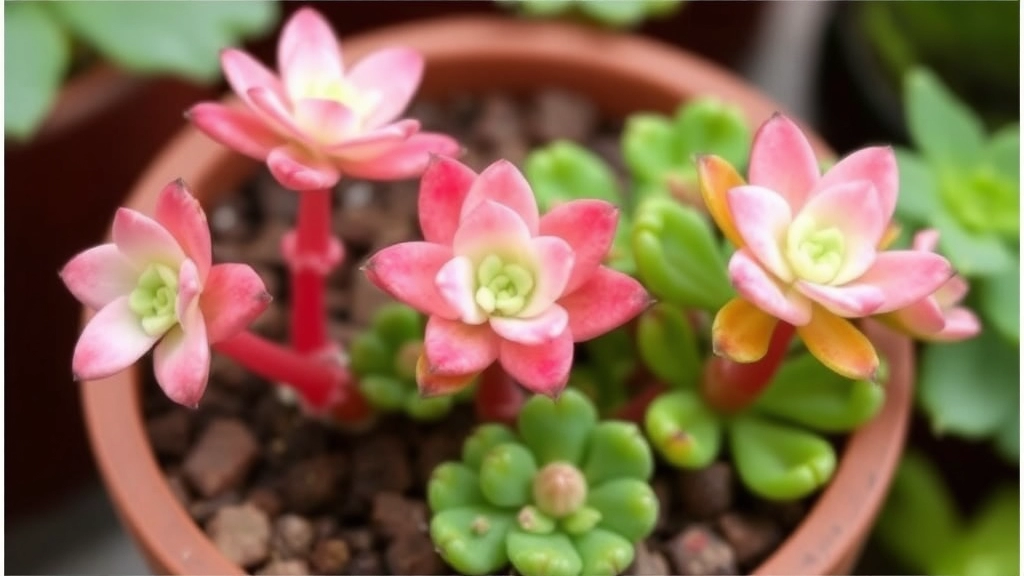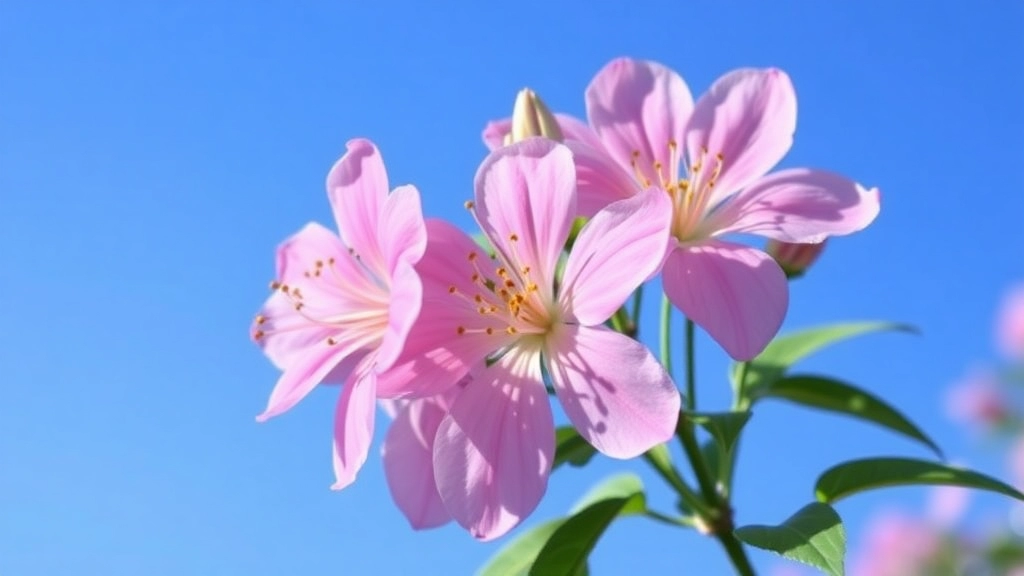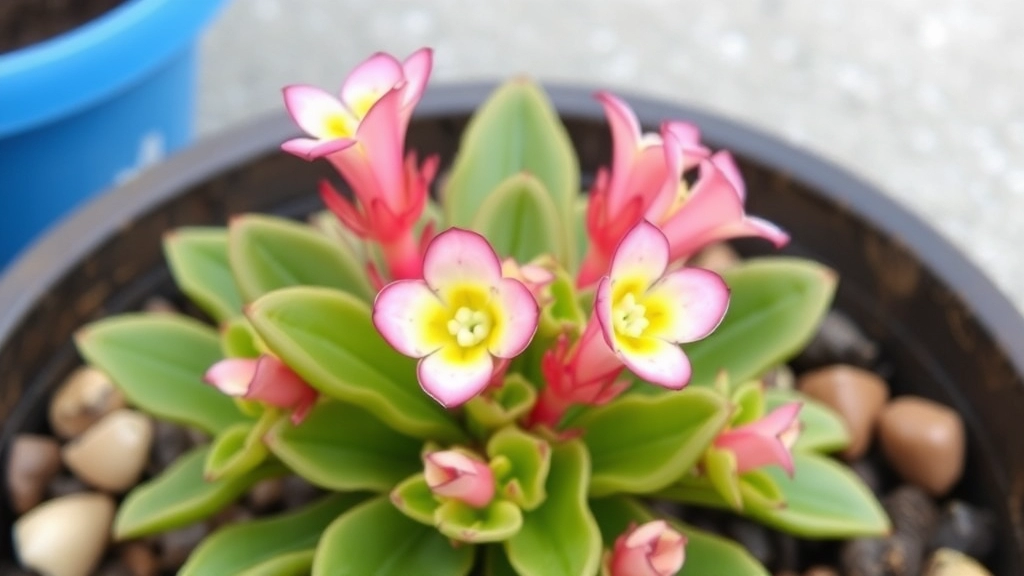Panda Plant Kalanchoe Tomentosa Care Guide
If you’re looking to add a unique and low-maintenance succulent to your collection, the Panda Plant Kalanchoe Tomentosa is a fantastic choice. Known for its fuzzy leaves and slow growth, this plant is both visually appealing and easy to care for. In this guide, I’ll share essential tips on how to keep your Panda Plant thriving, from ideal lighting conditions to proper watering techniques.
Lighting Conditions
First, let’s talk about lighting. The Panda Plant Kalanchoe Tomentosa thrives in bright, indirect sunlight. Too much direct sun can scorch its leaves, while too little light can stunt its growth. Finding the right balance is key to keeping your plant happy and healthy.
Watering Techniques
Now, onto watering: this succulent prefers to be on the drier side. Water thoroughly but allow the soil to dry out completely between waterings to prevent root rot. Keep reading for more detailed care instructions and tips to help your Panda Plant flourish.
Overview of Kalanchoe Tomentosa
Are you searching for a low-maintenance plant that adds a touch of charm to your home?
Kalanchoe Tomentosa, commonly known as the Panda Plant, is a delightful succulent that’s becoming increasingly popular among plant enthusiasts.
This unique plant is characterised by its fuzzy, grey-green leaves adorned with distinctive brown edges, resembling the ears of a panda.
Key Features of Kalanchoe Tomentosa:
- Origin: Native to Madagascar, the Panda Plant thrives in arid environments.
- Growth Habit: It typically grows to about 30-45 cm (12-18 inches) tall, making it an ideal choice for tabletops or windowsills.
- Lifespan: With proper care, Kalanchoe Tomentosa can live for several years, rewarding you with its striking foliage.
Kalanchoe Tomentosa is not just visually appealing; it’s also known for its resilience, making it perfect for both novice and experienced gardeners. For a detailed guide on how to care for this plant, check out our complete guide on caring for Kalanchoe Tomentosa.
If you’re interested in adding this charming succulent to your collection, you can also buy Kalanchoe Tomentosa online at the best prices.
Ideal Lighting Conditions for Panda Plant

So, you’ve got your Panda Plant, also known as Kalanchoe Tomentosa, and you’re wondering about its lighting needs? You’re not alone! Many plant lovers often fret over the right amount of light for their green companions.
Bright, Indirect Light is Key
The Panda Plant thrives in bright, indirect light. Think of a cozy spot near a window where the sun isn’t blasting directly on the leaves. Here’s what you should keep in mind:
- South or East-facing windows are usually the best spots.
- Avoid direct sunlight for long periods; it can scorch those lovely fuzzy leaves.
- If you notice the leaves stretching towards the light, it’s a sign your plant needs more brightness.
Low Light? No Thanks!
While the Panda Plant can tolerate lower light conditions, it won’t flourish. You might see slower growth, and those charming leaves may lose some vibrancy.
- If you have a dimmer area, consider using a grow light to supplement natural light.
Seasonal Changes Matter
Keep in mind that the intensity of light changes with the seasons. During winter, you might need to reposition your plant to ensure it gets enough light.
- Rotate your plant every few weeks for even growth and to prevent it from leaning.
Watering Requirements and Tips
As we delve deeper into the care of Kalanchoe Tomentosa, or the Panda Plant, one of the most pressing concerns for many plant owners is understanding its watering needs.
How Much Water Does a Panda Plant Need?
Panda Plants thrive on a careful balance of moisture. Overwatering is a common mistake that can lead to root rot, while underwatering can cause the leaves to shrivel. Here are some essential tips for watering your Panda Plant effectively:
- Watering Frequency: Aim to water your Panda Plant every 2-3 weeks during the growing season (spring and summer). In the dormant months (autumn and winter), reduce this to once a month.
- Soil Check: Always check the top inch of soil. If it feels dry, it’s time to water. If it’s still moist, wait a few more days.
- Watering Technique: When watering, do so thoroughly until water drains from the bottom of the pot. This ensures that the roots receive adequate moisture.
- Drainage: Ensure your pot has drainage holes. This prevents water from sitting at the bottom, which can lead to rot.
- Quality of Water: Use room temperature water to avoid shocking the plant. Rainwater or distilled water is ideal, as it is free from chemicals.
Signs of Improper Watering
Recognising the signs of over or underwatering can save your Panda Plant from distress:
- Overwatering: Yellowing leaves, mushy stems, and a musty smell from the soil.
- Underwatering: Wrinkled leaves, browning tips, and a general lack of vitality.
For more detailed information on how to care for your Panda Plant, check out our complete guide on Kalanchoe Tomentosa care. Additionally, if you’re interested in propagation techniques, our step-by-step propagation guide can be very helpful.
Temperature and Humidity Preferences

When caring for your Kalanchoe Tomentosa, commonly known as the Panda Plant, you might wonder: What temperature does it thrive in?
The Panda Plant is a resilient succulent that prefers a warm environment.
Ideal Temperature Range:
- Daytime: 20°C to 25°C (68°F to 77°F)
- Nighttime: No lower than 10°C (50°F)
Keeping your Panda Plant within this range promotes healthy growth and vibrant leaves.
Humidity Levels:
- Kalanchoe Tomentosa does best in low to moderate humidity.
- Aim for humidity levels between 30% to 50%.
Excess humidity can lead to problems like root rot, so it’s crucial to avoid overly damp conditions.
Tips for Maintaining Ideal Conditions:
- Place your Panda Plant in a warm room, away from drafts.
- If humidity is high, consider using a dehumidifier or ensure good air circulation.
- During colder months, keep it indoors to prevent exposure to frost.
Understanding these temperature and humidity preferences will set the stage for a thriving Panda Plant.
Best Soil for Panda Plant Growth
Choosing the right soil for your Kalanchoe Tomentosa, commonly known as the Panda Plant, is crucial for its overall health and growth. Many plant owners often wonder what type of soil will provide the best drainage and nutrients for this charming succulent.
Common Propagation Techniques for Kalanchoe Tomentosa

So, you’re loving your Panda Plant and wondering how to multiply that joy?
Propagation is a fantastic way to expand your plant family, and Kalanchoe Tomentosa makes it pretty easy.
Here are the most common techniques you can try:
1. Leaf Cuttings
- What You Need: A healthy leaf from your Panda Plant.
- Steps:
- Gently twist off a leaf from the stem.
- Let it dry for a few hours to form a callus.
- Place it on well-draining soil, ensuring it’s not buried too deep.
- Water sparingly until you see new growth.
2. Offsets
- What You Need: Small offsets that grow around the base of the plant.
- Steps:
- Carefully separate the offsets from the main plant.
- Make sure they have roots attached.
- Plant them in their own pots with cactus mix soil.
- Water lightly until they establish themselves.
3. Stem Cuttings
- What You Need: A healthy stem from your Panda Plant.
- Steps:
- Cut a stem about 4-6 inches long, making sure it has a few leaves.
- Allow the cut end to dry for a day or two.
- Plant it in soil, keeping it upright.
- Water sparingly and wait for roots to develop.
These methods are not just effective; they’re also a fun way to engage with your plant.
Just remember, patience is key!
Once you see new growth, you’ll know you’re on the right track.
How to Repot and Manage Growth
After ensuring your Kalanchoe tomentosa, commonly known as the Panda Plant, is thriving in its current environment, you may find it necessary to repot as it grows. Repotting not only provides fresh soil but also allows for root expansion, which is crucial for healthy growth.
When to Repot
- Signs of Root Bound: If you notice roots emerging from the drainage holes or the plant appears top-heavy, it’s time to repot.
- Frequency: Generally, repot every 2-3 years, or when the plant outgrows its pot.
Steps to Repot
- Choose the Right Pot: Select a pot that is 1-2 inches larger in diameter than the current one. Ensure it has drainage holes.
- Prepare the Soil: Use a well-draining soil mix, ideally a cactus or succulent blend.
- Remove the Plant: Gently take the Panda Plant out of its pot. You may need to tap the sides to loosen it.
- Inspect the Roots: Check for any dead or rotting roots. Trim them off with clean scissors.
- Position the Plant: Place the plant in the new pot, ensuring it sits at the same depth as before.
- Fill with Soil: Add fresh soil around the roots, pressing lightly to eliminate air pockets.
- Water Sparingly: After repotting, wait a week before watering to allow the roots to settle.
Managing Growth
To keep your Panda Plant healthy and encourage robust growth:
- Pruning: Trim any leggy or dead leaves to promote bushier growth.
- Fertilisation: Use a diluted, balanced fertiliser during the growing season (spring and summer).
- Monitoring: Keep an eye on its growth pattern. If it becomes too tall or sparse, consider pruning back.
For more detailed care tips on Kalanchoe tomentosa, check out our Succulent Kalanchoe Tomentosa Care Tips and Growing Guide. Additionally, if you are interested in propagating this plant, visit our Step-by-Step Guide to Propagate Kalanchoe Tomentosa.
Toxicity to Pets and Safety Precautions

So, you’ve got your lovely Kalanchoe Tomentosa, also known as the Panda Plant, but are you worried about your furry friends? You’re not alone! Many plant lovers wonder if their green companions are safe for pets.
Is the Panda Plant Toxic?
Good news: Kalanchoe Tomentosa isn’t highly toxic to pets, but it can still pose risks, especially to cats and dogs.
- Mild Toxicity: If ingested, it can cause mild gastrointestinal upset.
- Symptoms to Watch For:
- Vomiting
- Diarrhea
- Lethargy
If your pet has a nibble, don’t panic, but keep an eye on them. If they show any concerning symptoms, a quick visit to the vet is a smart move.
Safety Precautions
To keep your Panda Plant and pets happily coexisting, consider these tips:
- Placement: Keep your plant out of reach. A high shelf or a hanging planter can do wonders.
- Distraction: Provide your pets with safe toys or plants they can munch on, like cat grass. This might deter them from your beloved Panda Plant.
- Education: If you have kids, teach them not to feed plants to pets. It’s a good habit to instill early.
By being proactive, you can enjoy your Panda Plant without worrying about your furry pals.
As we move forward in our exploration of the Kalanchoe tomentosa, it’s essential to address a common concern for many plant owners: pests and diseases.
**Common Pests**
Panda plants can attract a few pesky intruders. Here are the most common pests you might encounter:
– **Mealybugs**: These small, white, cotton-like insects often cluster in leaf joints and on stems. They suck the sap from your plant, weakening it over time.
– **Spider Mites**: Tiny and often invisible to the naked eye, these pests leave fine webbing on the leaves and can cause yellowing and leaf drop.
– **Aphids**: These small, green or black insects can deform new growth and lead to a sticky residue called honeydew, which can encourage sooty mould.
**Signs of Infestation**
Keep an eye out for these indicators:
– **Discolouration**: Yellowing or browning leaves.
– **Sticky residue**: A sign of aphids or mealybugs.
– **Webbing**: A telltale sign of spider mites.
**Common Diseases**
While Kalanchoe tomentosa is relatively hardy, it can be susceptible to a few diseases:
– **Root Rot**: Often caused by overwatering, this disease leads to mushy roots and wilting leaves.
– **Powdery Mildew**: A fungal disease that appears as a white powdery substance on leaves, usually due to high humidity and poor air circulation.
**Prevention and Treatment**
To keep your panda plant healthy, consider these tips:
– **Regular Inspection**: Check your plant weekly for signs of pests or disease.
– **Proper Watering**: Ensure you’re not overwatering, as this can lead to root rot.
– **Air Circulation**: Place your plant in a well-ventilated area to prevent fungal issues.
– **Natural Remedies**: Use insecticidal soap or neem oil to treat infestations.
For more detailed advice on caring for this plant, you can refer to the [complete guide to Kalanchoe tomentosa care](https://planthq.org/succulent-kalanchoe-tomentosa-care-tips-and-growing-guide/). Additionally, if you’re interested in exploring different varieties, check out the [types of Kalanchoe tomentosa](https://planthq.org/types-of-kalanchoe-tomentosa-varieties-and-care-tips/).
Seasonal Flowering and Blooming Habits

So, you’ve got your Kalanchoe Tomentosa, also known as the Panda Plant, and you’re wondering about its flowering habits?
Let’s dive into what you can expect when it comes to blooms.
When Does It Flower?
- Typically, the Panda Plant blooms in late winter to early spring.
- Flowers can appear as clusters of tubular shapes, usually in shades of yellow or orange.
Conditions for Blooming
To encourage those lovely flowers, keep these tips in mind:
- Lighting: Ensure it gets plenty of bright, indirect sunlight.
- Watering: Reduce watering slightly during the winter months to mimic its natural dormancy.
- Temperature: Keep it warm, as it thrives in temperatures between 18°C to 24°C.
Why It Might Not Bloom
If your Panda Plant isn’t flowering, don’t fret! Here are a few reasons why:
- Insufficient Light: It might not be getting enough bright light.
- Too Much Water: Overwatering can stress the plant and hinder blooming.
- Nutrient Deficiency: Consider using a balanced fertiliser during the growing season to boost its health.
Personal Experience
I remember when my Panda Plant first bloomed. I was so thrilled to see those bright flowers pop up! It felt like a reward for the care I’d given it.
Tips for Growing Panda Plant Outdoors
As we look into the outdoor care of the Panda Plant, it’s essential to consider how its needs differ from indoor environments.
Choosing the Right Location
When growing Kalanchoe Tomentosa outdoors, selecting the ideal spot is crucial.
- Sunlight: Aim for a location that receives bright, indirect sunlight. Direct afternoon sun can scorch the leaves.
- Shelter: Consider a sheltered area to protect your plant from harsh winds and heavy rain.
Soil Considerations
The right soil mix is vital for outdoor growth.
- Well-draining Soil: Use a cactus or succulent potting mix to ensure proper drainage.
- pH Level: A slightly acidic to neutral pH (around 6.0 to 7.0) works best.
Watering Wisely
Outdoor conditions can vary significantly, so adjust your watering routine accordingly.
- Frequency: Water when the top inch of soil feels dry. This may mean watering more frequently during hot spells.
- Drainage: Ensure that your pot or garden bed has adequate drainage to prevent root rot.
Temperature and Protection
Panda Plants thrive in warm conditions but need protection from extreme weather.
- Temperature Range: Ideally, keep your plant in temperatures between 15°C to 27°C.
- Frost Protection: If you live in a cooler climate, bring your Panda Plant indoors during frost or cover it with a frost cloth.
Fertilisation Tips
Outdoor plants can benefit from occasional feeding.
- Balanced Fertiliser: Use a diluted, balanced fertiliser during the growing season (spring and summer).
- Frequency: Fertilise every four to six weeks for optimal growth.
Pest Management
Keep an eye out for common pests that may affect your Panda Plant.
Low-Maintenance Plant for Busy Owners
If you’re like me, juggling work, family, and a social life can leave little time for plant care.
That’s where the Kalanchoe Tomentosa, or Panda Plant, swoops in like a superhero.
This little guy is perfect for those of us who want greenery without the fuss.
Here’s why it’s a solid choice:
- Minimal Watering Needs:
- Only water when the soil is completely dry.
- You can easily skip a week or two without worry.
- Tough as Nails:
- Panda Plants can handle a range of conditions.
- They’re not picky about lightâjust avoid harsh direct sun.
- Slow Growth:
- This means less frequent repotting.
- You can enjoy its beauty without constant upkeep.
- Pest Resistance:
- While no plant is entirely pest-proof, Panda Plants are generally left alone.
- A quick visual check is all you need.
- No Special Soil Requirements:
- Any well-draining potting mix will do.
- You don’t need to stress about finding the âperfectâ blend.
Picture this: you come home after a long day, and instead of fretting over plant care, you can just admire your lovely Panda Plant.
It’s like having a pet that doesn’t need walking!
So, whether you’re a busy professional or just someone who loves a low-maintenance green friend, the Panda Plant fits right in.
For more detailed care tips, check out our Kalanchoe Tomentosa Care Tips and Growing Guide and explore the varieties and care tips for Kalanchoe Tomentosa.
FAQs for Panda Plant (Kalanchoe Tomentosa)
What type of lighting does the Panda Plant need?
The Panda Plant thrives in bright, indirect light. South or east-facing windows are ideal, but avoid direct sunlight for extended periods as it can scorch the leaves.
Can the Panda Plant survive in low light conditions?
While it can tolerate lower light, the Panda Plant will not flourish. You may notice slower growth and less vibrant leaves. Consider using a grow light if natural light is insufficient.
What is the ideal temperature range for the Panda Plant?
The Panda Plant prefers daytime temperatures between 20°C to 25°C (68°F to 77°F) and nighttime temperatures no lower than 10°C (50°F).
What humidity levels are best for the Panda Plant?
The plant does well in low to moderate humidity, ideally between 30% to 50%. Excessive humidity can lead to root rot.
How can I propagate my Kalanchoe Tomentosa?
There are three common methods for propagating the Panda Plant: leaf cuttings, offsets, and stem cuttings. Each method involves specific steps to ensure successful propagation.
Is the Panda Plant toxic to pets?
While Kalanchoe Tomentosa is not highly toxic, it can cause mild gastrointestinal upset in pets if ingested. Symptoms to watch for include vomiting, diarrhea, and lethargy.
What are some safety precautions to keep my pets safe around the Panda Plant?
Place the plant out of reach, use hanging planters, and provide your pets with safe toys or plants like cat grass to deter them from nibbling on the Panda Plant.
When does the Panda Plant typically flower?
The Panda Plant usually blooms in late winter to early spring, producing clusters of tubular flowers in shades of yellow or orange.
What conditions encourage the Panda Plant to bloom?
Ensure the plant receives plenty of bright, indirect sunlight, reduce watering during winter months, and maintain warm temperatures between 18°C to 24°C.
Why might my Panda Plant not be blooming?
Possible reasons include insufficient light, overwatering, or nutrient deficiency. Consider using a balanced fertilizer during the growing season to promote blooming.
References
-
Kalanchoe Tomentosa Growing Guide
-
Panda Plant Care – Gardening Know How
-
Kalanchoe Tomentosa Care Tips – Plant Care Today
